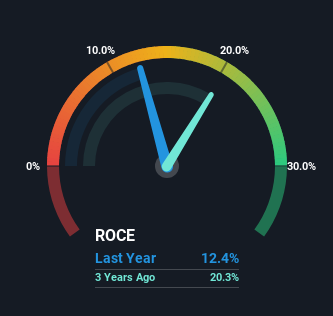Capital Allocation Trends At Integrated Research (ASX:IRI) Aren't Ideal
When it comes to investing, there are some useful financial metrics that can warn us when a business is potentially in trouble. Businesses in decline often have two underlying trends, firstly, a declining return on capital employed (ROCE) and a declining base of capital employed. This indicates to us that the business is not only shrinking the size of its net assets, but its returns are falling as well. On that note, looking into Integrated Research (ASX:IRI), we weren't too upbeat about how things were going.
What Is Return On Capital Employed (ROCE)?
If you haven't worked with ROCE before, it measures the 'return' (pre-tax profit) a company generates from capital employed in its business. The formula for this calculation on Integrated Research is:
Return on Capital Employed = Earnings Before Interest and Tax (EBIT) ÷ (Total Assets - Current Liabilities)
0.12 = AU$9.1m ÷ (AU$97m - AU$24m) (Based on the trailing twelve months to December 2023).
Therefore, Integrated Research has an ROCE of 12%. In absolute terms, that's a pretty normal return, and it's somewhat close to the Software industry average of 14%.
Check out our latest analysis for Integrated Research
Above you can see how the current ROCE for Integrated Research compares to its prior returns on capital, but there's only so much you can tell from the past. If you'd like to see what analysts are forecasting going forward, you should check out our free analyst report for Integrated Research .
The Trend Of ROCE
There is reason to be cautious about Integrated Research, given the returns are trending downwards. To be more specific, the ROCE was 35% five years ago, but since then it has dropped noticeably. And on the capital employed front, the business is utilizing roughly the same amount of capital as it was back then. Since returns are falling and the business has the same amount of assets employed, this can suggest it's a mature business that hasn't had much growth in the last five years. So because these trends aren't typically conducive to creating a multi-bagger, we wouldn't hold our breath on Integrated Research becoming one if things continue as they have.
On a side note, Integrated Research has done well to pay down its current liabilities to 25% of total assets. That could partly explain why the ROCE has dropped. What's more, this can reduce some aspects of risk to the business because now the company's suppliers or short-term creditors are funding less of its operations. Some would claim this reduces the business' efficiency at generating ROCE since it is now funding more of the operations with its own money.
The Bottom Line
In summary, it's unfortunate that Integrated Research is generating lower returns from the same amount of capital. We expect this has contributed to the stock plummeting 85% during the last five years. Unless there is a shift to a more positive trajectory in these metrics, we would look elsewhere.
If you want to continue researching Integrated Research, you might be interested to know about the 1 warning sign that our analysis has discovered.
If you want to search for solid companies with great earnings, check out this free list of companies with good balance sheets and impressive returns on equity.
Have feedback on this article? Concerned about the content? Get in touch with us directly. Alternatively, email editorial-team (at) simplywallst.com.
This article by Simply Wall St is general in nature. We provide commentary based on historical data and analyst forecasts only using an unbiased methodology and our articles are not intended to be financial advice. It does not constitute a recommendation to buy or sell any stock, and does not take account of your objectives, or your financial situation. We aim to bring you long-term focused analysis driven by fundamental data. Note that our analysis may not factor in the latest price-sensitive company announcements or qualitative material. Simply Wall St has no position in any stocks mentioned.

 Yahoo Finance
Yahoo Finance 
